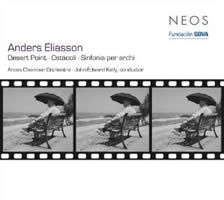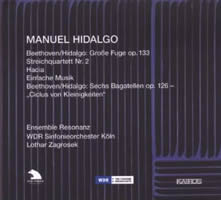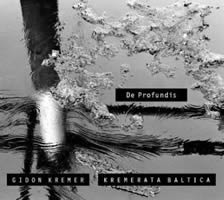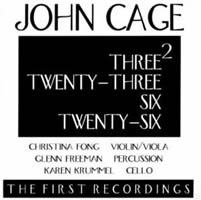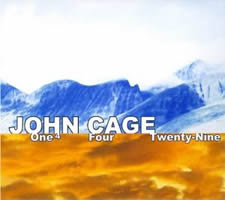String Theory 4: String Orchestras
|
Grant Chu Covell [November 2010.]
Allan PETTERSSON: Concerto No. 3 for String Orchestra (1956-57). Nordic Chamber Orchestra, Christian Lindberg (cond.). BIS CD 1590 (http://www.bis.se/). Distributed in the US by Qualiton (http://www.qualiton.com/). This is a companion release to the same forces’ 2009 recordings of Pettersson’s first two concertos and Antal Doráti’s arrangement of eight Barefoot Songs. Ever willful, Pettersson forges sternly lyric melodies in which every pitch counts. Typical of the composer, gorgeous tonal moments, usually cadential, emerge from dissonance. At 54 minutes, this is not a casual endeavor. Lindberg with the Nordic Chamber Orchestra (Sundsvalls Kammarorkester of Sweden) throw their weight behind it. This concerto is less forlornly abrasive than the symphonies. For other than the clinically depressed, this might be a fine Pettersson introduction.
Anders ELIASSON: Desert Point (1981); Ostácoli (1987); Sinfonia per archi (2001). Arcos Chamber Orchestra, John-Edward Kelly (cond.). NEOS 10813 (1 SACD) (http://www.neos-music.com/). Distributed in the US by Qualiton (http://www.qualiton.com/). A strange coincidence: another release of “difficult” string orchestra music also by a Swede. Eliasson’s acerbic Desert Point employs modernist effects, rather like watching water boil for 12:42. Ostácoli (“Hurdles”) is more concerned with structure, though it too offers compact variety. Sinfonia per archi, receiving its first recording, dials back the rhetoric. Less frenetic, the Sinfonia achieves Mahlerian gravitas. The central Allegro contains a striking pizzicato passage. The final Lento offers a hard-won benediction. Arcos Chamber Orchestra’s conductor John-Edward Kelly has appeared as saxophonist in Pettersson’s Sixteenth.
Manuel HIDALGO: Streichquartett Nr. 2 (1993-94); Hacia (1980); Einfache Musik (1989). Ludwig van BEETHOVEN: Große Fuge, Op. 133 (1825; arr. Hidalgo, 1992)*; Sechs Bagatellen, Op. 126, “Ciclus von Kleinigkeiten” (1823-24; arr. Hidalgo, 2009). WDR Sinfonieorchester Köln*, Lothar Zagrosek (cond.)*, Ensemble Resonanz. Kairos 0012982KAI (http://www.kairos-music.com/). Kairos’ program of Hidalgo and his Beethoven arrangements reignites an age-old question: Does music’s presentation affect our enjoyment? The answer here is yes. Hidalgo’s Beethoven disappoints on many fronts. A greedy fan of arrangements, I was let down by the orchestrated Große Fuge and the Six Bagatelles, Op. 126, arranged for strings. The fugue varies inconsistently between klangfarben doodling and Stokowskian Technicolor. The listener must wonder whether Hidalgo’s stylistic shifts are some sort of erudite commentary on Op. 133. The bagatelles don’t translate well for strings, and Ensemble Resonanz seems out of its depth. Hidalgo nudges Beethoven towards Schubert’s salon, recalling the many German Dances both composers cranked out to pay the bills. Several passages, No. 2’s opening hand-crossing and the heavenly floating B-major second subject of No. 4, made me pull out the piano original. No. 6’s Presto opening and closing curtain work well scaled-up. The arrangements wrap two Hidalgo string quartets and a string orchestra movement. He confesses that Lachenmann’s aesthetic influenced his first quartet, Hacia. However, Hidalgo seems to have borrowed just a few sounds absent the German’s jumbling intensity. Dedicated to Lachenmann, No. 2 retreats to where one hears the skeleton of a repeating tonal gesture passing from player to player. Indeed, Einfache Musik’s emphatically repeated pizzicatos and tonal arpeggios suggest that Hidalgo thrives on ambiguity or perhaps is unable utterly to abandon the classical.
“De Profundis.” Jean SIBELIUS: Scene with Cranes, Op. 44, No. 2 (1906). Arvo PÄRT: Passacaglia (2003, rev. 2007). Raminta ŠERKŠNYTÉ: De Profundis (1998). Robert SCHUMANN: Fugue No. 6 from Six Fugues on the Name B.A.C.H., Op. 60 (1845). Michael NYMAN: Trysting Fields (1992). Franz SCHUBERT: Minuet No. 3 and Trios in D minor, D. 89 (1813). Stevan Kovacs TICKMAYER: Lasset Uns Den Nicht Zerteilen (2005). Dmitri SHOSTAKOVICH: Adagio from Lady Macbeth of the Mtsensk District (1932). Lera AUERBACH: Sogno di Stabat Mater (2005, rev. 2009). Astor PIAZZOLLA: Melodía en La menor (Canto de Octubre) (1955). Georgs PELECIS: Flowering Jasmine (1947). Alfred SCHNITTKE: Fragment (n.d.). Kremerata Baltica, Gidon Kremer (vln, cond.). Nonesuch 287228-2 (http://www.nonesuch.com/). Kremer and his band have packaged an acidic dozen. Scene with Cranes’ obbligato clarinet pair ought to emerge magically, but here they stumble into a coarse beginning. I cannot recall Kremerata Baltica sounding so shrill. The collection mixes old and new, and several pieces of uncertain lineage. Schumann’s B.A.C.H. Fugue, Tickmayer’s briefly whirling Lasset Uns Den Nicht Zerteilen and Auerbach’s Sogno di Stabat Mater make me long for Thomaskirche’s immortal cantor and Auerbach’s Pergolesi original. While Nyman is generally hard to screw up, Trysting Fields duplicates Mozart phrases, often imprecisely, suggesting that the ensemble failed to see the point. (Compare the composer’s own recent performance on MN Records MN 113.) The big discovery is the fragment from Schnittke’s unfinished cantata for strings and harpsichord, its peppery dissonance suggesting a 1970s horror flick. I would ordinarily skip past the dedication (to Mikhail Khodorkovsky), were it not that Kremer disavows a political intent. Oh well, if you say so. Perhaps that’s why the cover’s liquid resembles oil.
John CAGE: Three2 (1991)a; Twenty-Three (1988)b; Six (1991)c; Twenty-Six (1991)d. Christina Fongb, d (vln, vla), Karen Krummelb (vlc), Glenn Freemanac, (perc). OgreOgress productions 643157094623 (http://www.ogreogress.com/). John CAGE: One4 (1990)a; Four (1989)b; Twenty-Nine (1991)c. Christina Fongb, c (vln, vla), Karen Krummelb, c (vlc), Glenn Freemana, c (pno, perc), Michael Crawfordc (cb). OgreOgress productions 643157342823 (http://www.ogreogress.com/). I anticipated grousing at these multi-tracked performances. While Cage distrusted recordings, now that he is no longer here to lend a hand, we should be appreciative of any interpretation, especially of the large-ensemble works. These recordings showcase several interrelated late-period number pieces, among them the predominantly string orchestra Twenty-Three, Twenty-Six and Twenty-Nine. My only qualm: The notes are embossed upon the discs. In 1991 Cage put forth three large-ensemble pieces which can be played separately or in combination. Twenty-Six masses 26 violins, Twenty-Eight requires 28 winds and brass, and Twenty-Nine asks for percussion, piano and low strings, requiring a total of — you guessed it — 29 players. Each piece lasts its title’s number of minutes. OgreOgress offers seven possible combinations across four releases. Let me anticipate a smart-aleck comment: The eighth combination — which is to play none of them — is an altogether different Cage opus. OgreOgress’ two most recent Cage releases are generous DVD-Audio discs, each with more than two hours of music and the remaining combinations among other late works. Twenty-Three requires 13 violins, 5 violas and 5 cellos, and stands alone. Fong takes the upper 18 parts, Krummel the lower 5. Eschewing vibrato, the sustained strings create a metallic sheen. There is no melodic line, only a 23-minute continuously changing complex texture, frightening and alluring in equal measure. Fong sets 26 violins in motion, massing and releasing slow arcs for Twenty-Six. The consistent timbre conjures purring electronics, and the similar envelope focuses attention upon the slowly varying sound, putting one in mind of an organ or shō. There are rare moments of silence and a smattering of voices. Twenty-Nine will surprise. Perhaps the minimalist movement’s drone branch influenced Cage. Scored for violas, cellos, basses, bowed piano, timpani and percussion, Twenty-Nine creates an oppressive, slow-moving maelstrom. The grumbling center of gravity remains low even when violas and cellos reach for the heights. Overall the steady shifting imitates a slowed-down tape effect. I’d love to hear a period ensemble like Concerto Köln playing any of these. For percussion, Three2, Six and One4 require three, six or one player, as indicated. The nine-minute Three2 asks for three sustainable percussion sounds. Freeman combines mark tree and flexatone with a plain-vanilla suspended cymbal. This recording of Six occupies just three minutes. It’s possible that each player performs on more than one instrument. Here too Freeman’s watchword is variety. I hear cymbal, low drum, sleigh-bells, and sine waves. One4 directs a single percussionist to place 14 sounds within a seven-minute span. (The left hand has six gestures, the right hand eight, with one hand perhaps assisting the other.) Written for the Arditti Quartet, Four may take 10, 20 or 30 minutes to perform. The disc provides instructions for sequencing the tracks in order to recreate the several versions. While Four may have been groundbreaking with regard to its structural novelty, it pales in comparison to the powerful Twenty-Nine.
Auerbach, Beethoven, Cage, Eliasson, Hidalgo, Nyman, Pärt, Pelecis, Pettersson, Piazzolla, Schnittke, Schubert, Schumann, Shostakovich, Sibelius, Tickmayer
[More Grant Chu Covell, String Theory]
[More
Auerbach, Beethoven, Cage, Eliasson, Hidalgo, Nyman, Pärt, Pelecis, Pettersson, Piazzolla, Schnittke, Schubert, Schumann, Shostakovich, Sibelius, Tickmayer]
[Previous Article:
Olivier Greif 1.]
[Next Article:
Diabelli Days]
|

